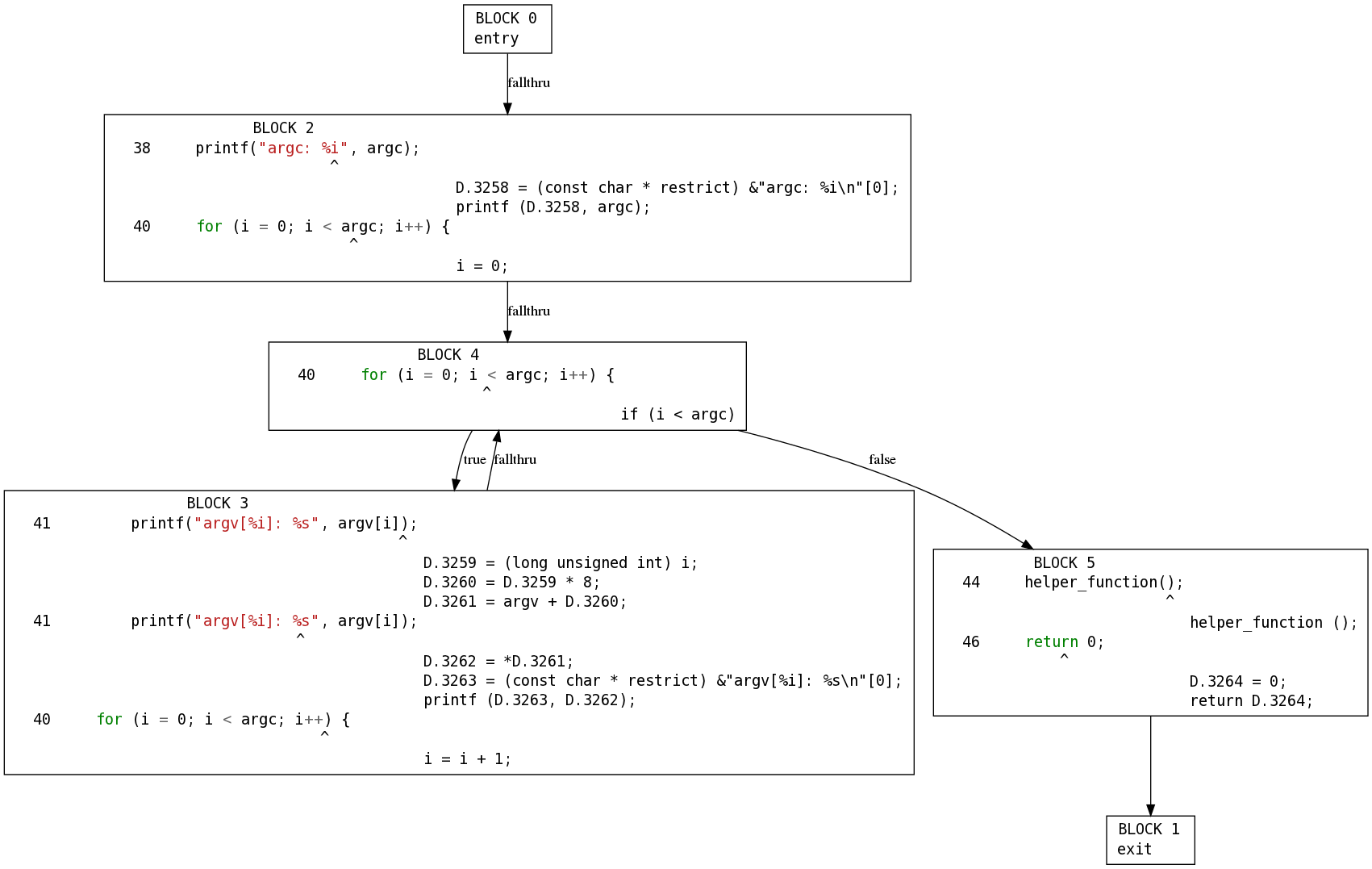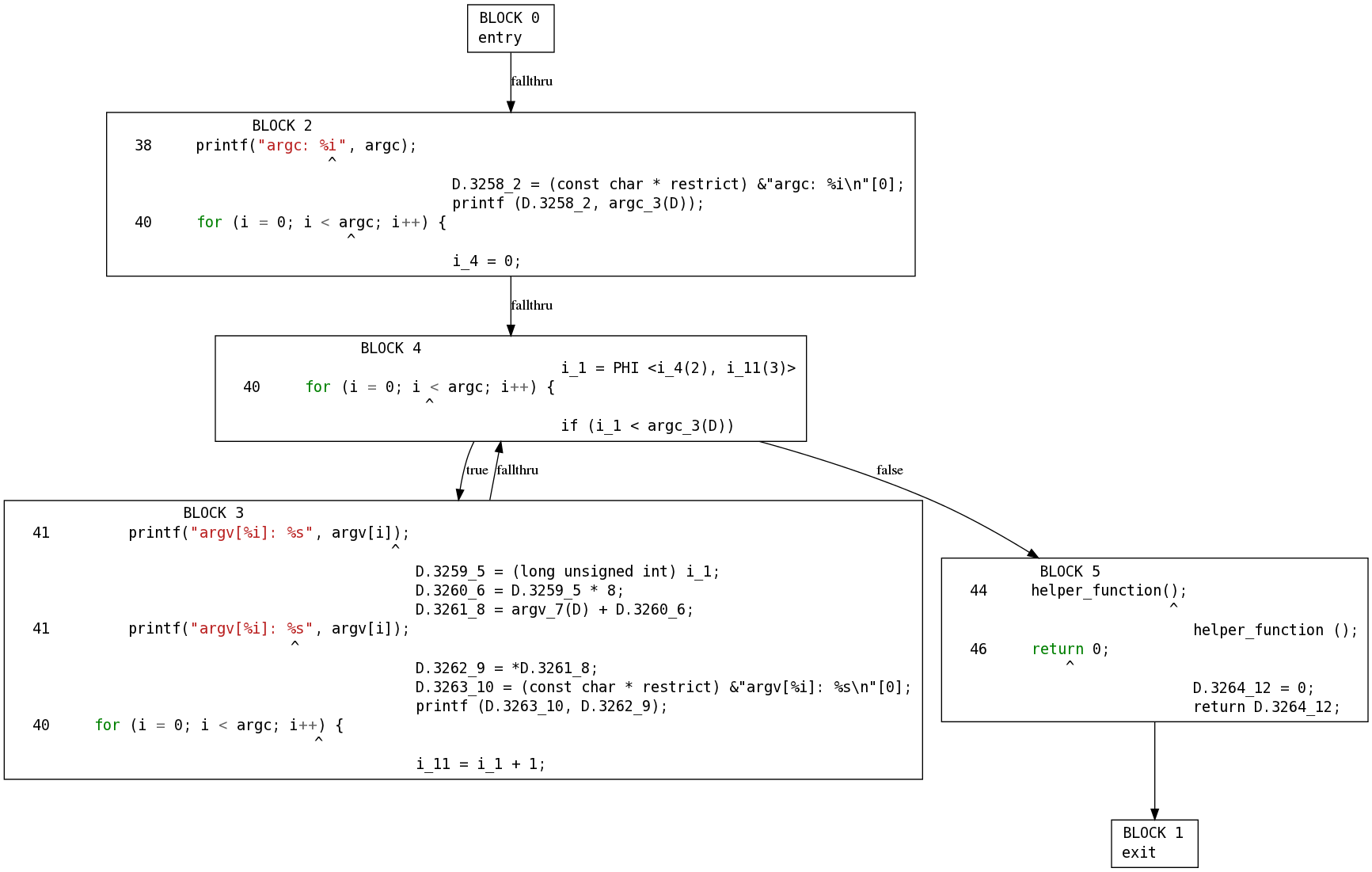Overview of GCC’s internals¶
To add a new compiler warning to GCC, it’s helpful to have a high-level understanding of how GCC works, so here’s the 10,000 foot view of how GCC turns source code into machine code.
The short version is that GCC applies a series of optimization passes to your code, gradually converting it from a high-level representation into machine code, via several different internal representations.
Each programming language supported by GCC has a “frontend”, which parses the source files.
For the case of C and C++, the preprocessor manipulates the code first before the frontend sees it. You can see the preprocessor output with the -E option.
Exactly what happens in each frontend varies by language: some language frontends emit language-specific trees, and some convert to a language-independent tree representation known as GENERIC. In any case, we eventually we reach a representation known as GIMPLE. The GIMPLE representation contains simplified operations, with temporary variables added as necessary to avoid nested sub-expressions.
For example, given this C code:
int main(int argc, char **argv) { int i; printf("argc: %i\n", argc); for (i = 0; i < argc; i++) { printf("argv[%i]: %s\n", argv[i]); } helper_function(); return 0; }
we can see a dump of a C-like representation of the GIMPLE form by passing -fdump-tree-gimple to the command-line:
$ gcc -fdump-tree-gimple test.c $ cat test.c.004t.gimple
giving something like this:
main (int argc, char * * argv)
{
const char * restrict D.3258;
long unsigned int D.3259;
long unsigned int D.3260;
char * * D.3261;
char * D.3262;
const char * restrict D.3263;
int D.3264;
int i;
D.3258 = (const char * restrict) &"argc: %i\n"[0];
printf (D.3258, argc);
i = 0;
goto <D.2050>;
<D.2049>:
D.3259 = (long unsigned int) i;
D.3260 = D.3259 * 8;
D.3261 = argv + D.3260;
D.3262 = *D.3261;
D.3263 = (const char * restrict) &"argv[%i]: %s\n"[0];
printf (D.3263, D.3262);
i = i + 1;
<D.2050>:
if (i < argc) goto <D.2049>; else goto <D.2051>;
<D.2051>:
helper_function ();
D.3264 = 0;
return D.3264;
}
It’s far easier to see the GIMPLE using:
./gcc-with-python examples/show-gimple.py test.c
which generates bitmaps showing the “control flow graph” of the functions in the file, with source on the left-hand side, and GIMPLE on the right-hand side:
Each function is divided into “basic blocks”. Each basic block consists of a
straight-line sequence of code with a single entrypoint and exit: all branching
happens between basic blocks, not within them. The basic blocks form a
“control flow graph” of basic blocks, linked together by edges. Each block
can contain a list of gcc.Gimple statements.
You can work with this representation from Python using gcc.Cfg
Once the code is in GIMPLE form, GCC then attempts a series of optimizations on it.
Some of these optimizations are listed here: http://gcc.gnu.org/onlinedocs/gccint/Tree-SSA-passes.html
If you’re looking to add new compiler warnings, it’s probably best to hook your code into these early passes.
The GIMPLE representation actually has several forms:
- an initial “high gimple” form, potentially containing certain high-level operations (e.g. control flow, exception handling)
- the lower level gimple forms, as each of these operations are rewritten in lower-level terms (turning control flow from jumps into a CFG etc)
- the SSA form of GIMPLE. In Static Single Assignment form, every variable is assigned to at most once, with additional versions of variables added to help track the impact of assignments on the data flowing through a function. See http://gcc.gnu.org/onlinedocs/gccint/SSA.html
You can tell what form a function is in by looking at the flags of the current pass. For example:
if ps.properties_provided & gcc.PROP_cfg:
# ...then this gcc.Function ought to have a gcc.Cfg:
do_something_with_cfg(fn.cfg)
if ps.properties_provided & gcc.PROP_ssa:
# ...then we have SSA data
do_something_with_ssa(fn)
Here’s our example function, after conversion to GIMPLE SSA:
./gcc-with-python examples/show-ssa.py test.c
You can see that the local variable i has been split into three versions:
- i_4, assigned to in block 2
- i_11, assigned to at the end of block 3
- i_1, assigned to at the top of block 4.
As is normal with SSA, GCC inserts fake functions known as “PHI” at the start of basic blocks where needed in order to merge the multiple possible values of a variable. You can see one in our example at the top of the loop in block 4:
i_1 = PHI <i_4(2), i_11(3)>
where i_1 either gets the value of i_4, or of i_11, depending on whether we reach here via block 2 (at the start of the iteration) or block 3 (continuing the “for” loop).
After these optimizations passes are done, GCC converts the GIMPLE SSA representation into a lower-level representation known as Register Transfer Language (RTL). This is probably too low-level to be of interest to those seeking to add new compiler warnings: at this point it’s attempting to work with the available opcodes and registers on the target CPU with the aim of generating efficient machine code.
See http://gcc.gnu.org/onlinedocs/gccint/RTL.html
The RTL form uses the same Control Flow Graph machinery as the GIMPLE representation, but with RTL expressions within the basic blocks.
Once in RTL, GCC applies a series of further optimizations, before finally generating assembly language (which it submits to as, the GNU assembler): http://gcc.gnu.org/onlinedocs/gccint/RTL-passes.html You can see the assembly language using the -S command line option.
$ ./gcc -S test.c
$ cat test.s

